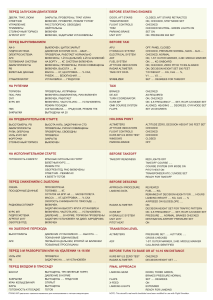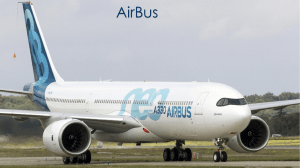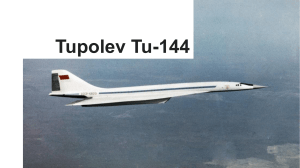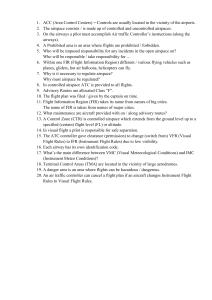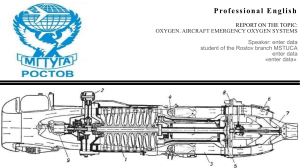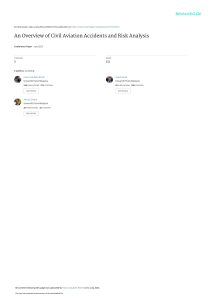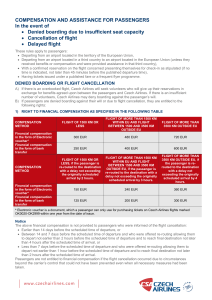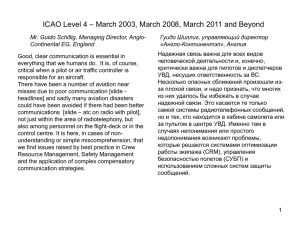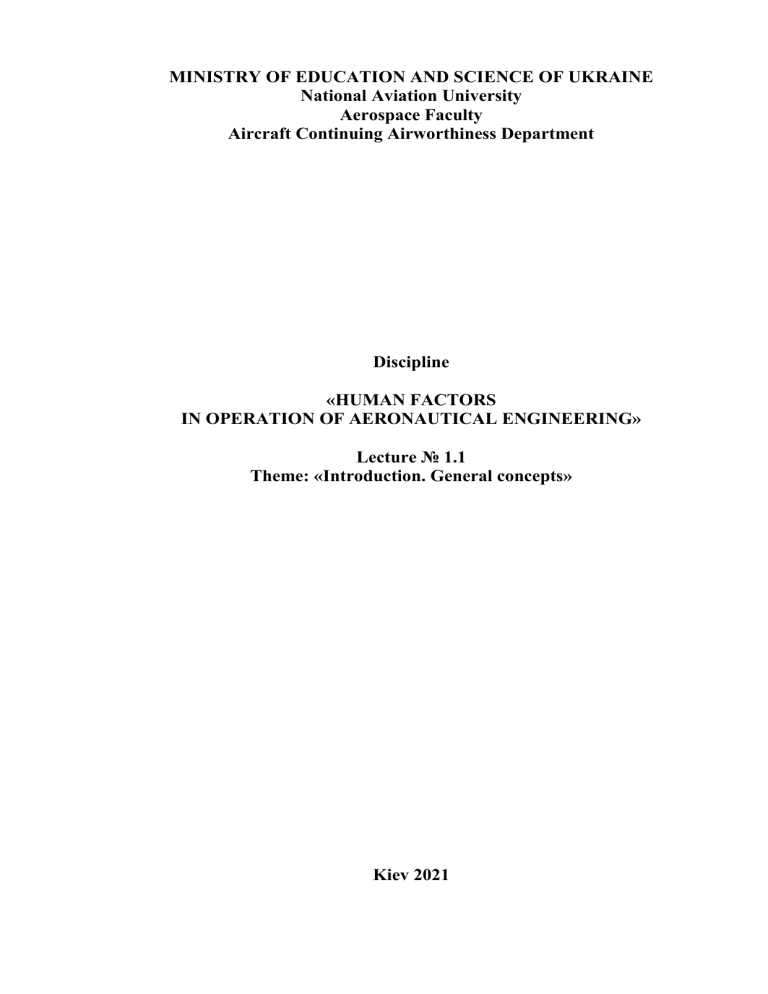
MINISTRY OF EDUCATION AND SCIENCE OF UKRAINE National Aviation University Aerospace Faculty Aircraft Continuing Airworthiness Department Discipline «HUMAN FACTORS IN OPERATION OF AERONAUTICAL ENGINEERING» Lecture № 1.1 Theme: «Introduction. General concepts» Kiev 2021 Content: 1. Introduction. The basic definitions. 2. Analysis of the reasons of the aviation events occurring in civil aviation. 3. Interaction of components of human-machine systems. 3.1. “SHEL” model. 3.2. Human error in the process of technical maintenance. 1. Introduction. The basic definitions The discipline «Human factor in operation of aeronautical engineering » is taught in 10-th semester in the form of lectures and laboratory works. 18 hours is taken on lectures and laboratory works, however 89 hours are provided on independent studying. For control of level of knowledge on discipline the reporting in the form of two modular examinations is provided. A result of studying of discipline is examination. In the course of discipline studying it is recommended to use the following literature: 1. The human factor. Collections of materials №1,3,12 (Circular ICAO). 2. Problems of safety of flights. М: VINITI. 3. Bases of engineering psychology. Educ. lit. under the editorship of B.F.Lomova. М, "Higher school", 1977.336 with. 4. Skrypets A.V. "Bases of aviation engineering psychology":Educ. lit. - К: NAU, 2002. - 532 p. 5. A directory on engineering psychology / Under the editorship of B.F.Lomova. - М: Mechanical engineering, 1982. - 368 p. Aeronautical engineering maintenance - the important compound process of aviation system providing its normal functioning. As the volume of an airline traffic grows, and rigid requirements to the schedule of commercial flights lead to necessity of increasing intensity of aircraft usage, the requirements for in time aeronautical engineering maintenance will be increased also. Because of this there will be additional possibilities of the errors admitted by experts to occurre, and as consequence - ruptures in a chain of aviation system safety. The purpose of the given discipline - to show, how possibilities and restrictions of the person can affect its activity and safety of an airline traffic in certain conditions of carrying out maintenance and inspections. According to some researches, the quantity of the incidents connected with maintenance and incidents on an air transportation has considerably increased. For 10 years (1985 … 95) mid-annual growth of aviation events quantity connected with maintenance has exceeded 100 %, while the number of flights has increased less than by 55 %. The problem of "the human factor" (HF), from the moment of aircraft origin, always admitted to be actual at the solution of questions of reliability of system "person - flying machine" functioning, but concerned basically, flight crew. To the 2 questions of the account of this problem in the aeronautical engineering maintenance insufficient attention was paid. The more reliably machines are, the role of HF in aviation accidents is concerned to be greater, however during last years correlation between "technique factors" and "human factors" remains approximately constants (drawing 1.1). It means that with improvement of aviation techniques, the methods and ways of organization of person-operator activity (the pilot, the navigator, the flight engineer, the stuff of the aeronautical engineering maintenance)is improved, so the human link in improved in aviation. АA,% (АT) Human factor 60 53 40 23 20 Technical factor 0 20 40 47 1957 1970 60 74 АA,% (HF) 1982 2006 Fig. 1.1. Percentage of the aviation accidents in the civil aviation of the USSR and the UIS on aircrafts with TJE During the last years the statistics of huge flight accidents persistently convinces that approximately 80 % of them are anyhow connected with HF. As the human factor we will understand a science about people in those conditions in which they live and work, about their interaction with machines and procedures, and also about interaction between people. At HF studying people possibilities and restrictions in their professional work are considered, i.e. what they are capable or are not capable to carry out in concrete conditions. Also ability to use techniques is an element of possibilities and restrictions of the person as it demands from it abilities to carry out the professional duties of safely (possibility) within the limits of the established parameters and in certain operational conditions that includes also ability of the person to maintain the machine (restriction). As the basis of success in business of safety of flights and activity of the 3 person in aviation system, taking into account its restrictions, the system approach should serve. 2. Analysis of the reasons of the aviation events occurring in civil aviation. The analysis of safety of flights in civil aircraft shows that the most dangerous airline in the world was - the Soviet Aeroflot, despite it to planes of foreign airlines also there were heavy aviation incidents. The maximum quantity of the lost people in one aviation incident: - "KLM" and "Pan-Ameriken" (an island of Tenerif) - 583 pass., 27.03.1977., when two Б-747 have faced on the earth on Canary Islands; - 12.08.1985. Plane B-747 of Japanese airline JAL has faced mountain Fujiyama near Tokyo because of control loss, 520 foreheads were lost; In the USSR and the UIS: - 8/11/1979 collision of planes Tu-134A, was lost 178 people, including football players of a command "Pahtakor"; - 10.06.1985 accident of the plane Tu-154 - 200 people. Aircraft flight on the autopilot and has got to a warm layer of air, the autopilot has deduced the plane on stalling angles of attack, the plane has got to a vertical dive; - 5/3/1985 collision of An-26 and Tu-134 A near Lvov, was lost 94 people; - 1/8/1996 at the take off at airport Ndolo near Kinshasa (Zaire) plane An-32 of the company «Moscow airlines» ran into the capital market. 350 persons were lost, 470 have got wounds; - 12/6/1997 accident of An-124 "Ruslan" in Irkutsk. There were two fighters of Su-27 onboard, 71 people were lost; - 7/2/2002 collision of Tu-154 а/c "Bashkiria" and cargo "Boinga-757" on border of Germany and Switzerland, was lost 71 people; - accident of Tu-154 of the Russian airline near Donetsk in the summer 2006. The plane at the big altitude has entered the stalling regime and with the big vertical speed has faced with earth, has collapsed and has burnt down. 170 persons were lost; - accident of Russian Airbus А-310 а/c "Siberia" in а/p Irkutsk 9.07.2006. Undershooting of the plane with working engine out of the runway. From 203 persons onboard was lost 124. In accordance with ICАО, three quarters of all flight incidents occur within 3 km from runways. From the materials of a foreign papers from the analysis of the Boeing company (on the end 1990г.) for 30 years of operation of passenger planes, 80 % of all flight incidents are happening on a take off and landing regimes. So aviation incidents were distributed on the flight stages as follows (table 1.1) Table 1.1 - Distribution of AA on flight stages а Flight stages Taxing Run Climb Cruise % АA 3,3 17,6 6,5 5,2 4 Decrease Expectation and landing approach Landing Run 3,3 11,8 16,3 24,8 Take off and landing remain the most dangerous parts of flight, basically, because of a lack of time or flight altitude to understand the arising problems connected with display of technical, meteorological or "human" factors. In 2006 in civil aviation of the states-participants of the Agreement on civil aviation and about use of air space there were 33 АA, including 17 accidents in which 466 persons were lost. On the state accessory aircraft (Ukraine, Russia) accident and a victim were distributed as follows drawing 1.2. As a whole on park of aircrafts quantity of АA has increased in 1,3 times, the quantity of the lost people in accidents (in 4,6 times) has considerably increased. In 2006 at regular passenger transportations the victims were in 2 times more than for 10 previous years. It is necessary to agree that human errors are inevitable. Anybody, whether it is the designer, the engineer, the head or the pilot, cannot carry out the duties constantly ideally. 12 Катастрофы 10 8 6 4 2 0 1997 1998 1999 2000 2001 2002 2003 2004 2005 2006 Годы Russia Ukraine 5 350 Количеств о жертв 300 250 200 150 100 50 0 1997 1998 1999 2000 2001 2002 2003 2004 2005 2006 Годы Fig. 1.2. Distribution of absolute indicators (Accidents and quantity of victims) in civil aviation of Ukraine and Russia during 1997-2006 3. Interaction of components of human-machine systems. 3.1 “SHEL” model. For understanding HF it is convenient to use conceptual model as it allows to carry out the stage-by-stage approach. On one of scheme variants this model is represented in the form of the blocks showing various components of HF (fig. 3.1). The “SHEL” model (the abbreviation is made of first letters of English words of its components) has been developed for the first time by Edwards in 1972, and then in 1975 it was added by the Houkins diagram illustrating it. These components designate the following: Liveware - a live being, the person, the subject; Hardware - the machines, techniques; Software - rules, instructions, symbols, procedures; Environment - conditions in which first three elements cooperate. Fig. 3.1. “SHEL” model 6 This model does not reflect all interrelations between components, especially that are beyond HF and forms only a basis for understanding of HF. In the model centre there is a person - the most critical and flexible component of system. Borders of this block are difficult and amorphous, and consequently other components of system should be carefully driven to it in order to avoid undesirable pressure and possible failures in system. For maintenance of such compatibility it is important to know good prominent features of a central component of system. We will consider the most important characteristics of a central component of the given model. Physical sizes and form. At designing of any workplace and bigger parts of the equipment a data about the sizes and parameters of movement of various parts of a human body play the main role, although they can be different depending on the age of the person, its ethnics, a sex and etc. Physiological requirements. Data about requirements of the person in meal, water and oxygen can be borrowed from physiology and biology. Characteristics of perception of the information. For reception of the information about external and internal world the person has the various sense organs allowing it to react to events and to carry out demanded problems. However these sense organs are subject to degradation for some reasons. Information processing. Possibilities of the person in this area are seriously limited. The bad design of the device or system of the warning alarm system very often grow out of that at designing possibilities and restrictions of the person concerning information processing, i.e. such factors, as a nervous tension, motivation, short-term and long-term memory have not been considered. Features of reaction of the person on the received information. As soon as the information is apprehended by sense organs and processed, to muscles the signal to react to it is transmitted. Reaction can be expressed in the form of physical operating movements or in the dialogue beginning in this or that form. Environment conditions. The temperature, pressure, humidity, noise, time of day, light exposure degree influence work and state of health of the person. The height, the closed space, stressful or monotonous working conditions also can influence working capacity of the person. The subject is "a central" part of model “SHEL” HF. Other components should be appropriate amount to adapt and be co-ordinated with this "central" part. Let's consider interrelations between separate blocks of model. The subject - object. The question of interaction arises is more often, so far as concerns systems of the interface of the person and the car, namely: at designing of armchairs taking into account characteristics of a human body; displays taking into account possibilities of mastering of the information the user; and also controls, their coding and placing. The user can and not suspect about presence of defects of system “L - H” even if they finally will lead to accident as natural ability of the person to adapt to defects of system masks, but does not liquidate them. The subject - procedures. Interrelations of the person with such non-material components of system, as rules, managements, control lists, symbolic and the 7 computer software. The subject - environment. Importance of the interface of type “the person environment” during flight has been established by one of the first. Originally taken measures have been directed on adaptation of the person to corresponding conditions of environment (helmets, flight suits, oxygen masks, suits). Later the return tendency was outlined - to adapt environment for human body possibilities (hermetic sealing and air conditioning systems, sound insulation). The subject - the subject. It is an interaction kind between people. Training of the personnel and check of its professional suitability is traditionally conducted on an individual basis. If each member of a work collective has good vocational training it is natural to make the assumption, as all such collective, as a whole, will operate professionally and effectively. But, unfortunately, it not always so and consequently recently more and more attention it is given to the analysis of failures in work of groups of professionals. Flight crews, changes of dispatchers of air traffic, a brigade of technicians on service ВС and other experts work in collectives and, therefore the mutual relations developing in such collective, leave the mark on their behavior and working capacity. 3.2. Error of the person in the process of maintenance. Owing to specific features of an error of the person in the environment of maintenance service are shown in the form which is distinct from those in what it occurs in other working conditions, for example in a cabin of flight crew or in a hall of dispatchers. In the contrast to "real-time" character of an error of flight crew, and work of the dispatcher, an error in process of maintenance very often is not shown during its fulfillment. In certain cases the technician serving the plane, never learns about the admitted error because its consequences can be shown only after a while product operating time. So, for example, in case of infringement of fastening of a disk of the turbine of the engine, by airline "Sy-City" plane DC-10 in 1989, the prospective error at repair of the engine and its inspection has been admitted seventeen months prior to incident. In sphere of maintenance there is no analogues of the registrar of communication in a cabin, to a recorder of the flight data or a recorder tape of service, i.e. there are no the devices which in detail registries the process of performance of operations of maintenance service. In maintenance the error of the person is usually shown in unintentionally caused malfunction of the flight vehicle (physical degradation or refusal) which reason can be explained action or inactivity of the technical experts serving it. The error of the person in process of maintenance can be of two principal types: In the first case it is concrete malfunction of the aircraft which was not before beginning of carrying out maintenance; Result of an error of the second kind - is not revealing of undesirable or unsafe condition of flight vehicle at performance of maintenance the purpose of 8 which consists in detection of such condition. Examples of such errors are: the crack is not noticed during visual observation in a power unit or dismantle of the serviceable block of the electronic equipment instead of faulty, because of incorrectly established cause of defect. Such errors can be caused because of insufficient vocational training, shortage of the allocated resources or the tools necessary for maintenance, deficiency of time, etc. Wrong installation of components, inattentive observation and control of a condition of products are most often repeating errors at maintenance. The data concerning psychological aspects, confirms that the organizations can both prevent incidents, and promote their occurrence. Failures can be of two types, depending on time of display of their consequences. Active failure - represents error or infringement which immediately cause an adverse effect. Such errors are usually made by the operator of "first line". Actions of the pilot undertaking a control lever by cleaning of the chassis instead of a control lever by flaps, serve as a vivid example of a cause of a failure of this type. Hidden failure - grows out of the decision or actions which have been carried out long before incident and which consequences can not be shown for a long time. Such failure are usually generated at levels of decision-making and an establishment of rules or at level of a linear management, i.e. people, is far from the occurred event as after time, and space. Hidden failures which grow out of doubtful decisions or wrong actions though do not cause harm if they are shown separately, can co-operate with each other, creating «a window of possibilities» for the pilot, dispatcher or the aircraft mechanic to make the action leading to active refusal, destroying all kinds of protection of system, and as consequence - to incident. In such cases operators of "first line" become "successors" of defects of system as they come up against a situation baring hidden defects. 9 Glossary 1. Civil aviation – is one of two major categories of flying, representing all nonmilitary aviation, both private and commercial. Most of the countries in the world are members ICAO and work together to establish common standards and recommended practices for civil aviation through that agency. 2. ICAO – International Civil Aviation Organization. 3. Aircraft maintenance – is the overhaul, repair, inspection or modification of an aircraft or aircraft component. Maintenance includes the installation or removal of a component from an aircraft or aircraft subassembly, etc. 4. Aviation accident – is defined in the Convention on International Civil Aviation Annex 13 as an occurrence associated with the operation of an aircraft which takes place between the time any person boards the aircraft with the intention of flight and all such persons have disembarked, in which a person is fatally or seriously injured, the aircraft sustains damage or structural failure or the aircraft is missing or is completely inaccessible. 5. Aerospace engineering – is the primary branch of engineering concerned with the design, construction, and science of aircraft and spacecraft.[1] It is divided into two major and overlapping branches: aeronautical engineering and astronautical engineering. The former deals with craft that stay within Earth's atmosphere, and the latter with craft that operate outside it. 6. Taxiing – is the movement of an aircraft on the ground, under its own power, in contrast to towing or push-back where the aircraft is moved by a tug. The aircraft usually moves on wheels, but the term also includes aircraft with skis or floats (for water-based travel). 7. Landing approach – the approach to a landing field by an airplane 8. Malfunction – is when something functions wrongly or does not function at all. 9. Dispatchers – are communications personnel responsible for receiving and transmitting pure and reliable messages, tracking vehicles and equipment, and recording other important information. 10. Flaps – are normally hinged surfaces mounted on the trailing edges of the wings of a fixed-wing aircraft to reduce the speed an aircraft can be safely flown at and to increase the angle of descent for landing without increasing air speed. 10 # 1 2 3 4 5 6 Questions and Answers Questions Answers What is “Human factor”? It is a science about people in those conditions in which they live and work, about their interaction with machines and procedures, and also about interaction between people. At HF studying people possibilities and restrictions in their professional work are considered, i.e. what they are capable or are not capable to carry out in concrete conditions. Why does the Human As the volume of an airline traffic grows, and factor play the more rigid requirements to the schedule of commercial and more important flights lead to necessity of increasing intensity of role in aviation safety? aircraft usage, the requirements for in time aeronautical engineering maintenance will be increased also. Because of this there will be additional possibilities of the errors admitted by experts to occur, and as consequence − ruptures in a chain of aviation system safety. What is the purpose of The purpose is to show, how possibilities and the discipline “Human restrictions of the person can affect its activity and factor”? safety of an airline traffic in certain conditions of carrying out maintenance and inspections. What are the most In accordance with ICАО, three quarters of all dangerous stages of flight incidents occur within 3 km from runways. flight? What are the Take off and landing remain the most dangerous reasons? parts of flight, basically, because of a lack of time or flight altitude to understand the arising problems connected with display of technical, meteorological or "human" factors. What is “SHELL”? For understanding HF it is convenient to use Who had been conceptual model as it allows to carry out the stagedeveloped it? by-stage approach. On one of scheme variants this model is represented in the form of the blocks showing various components of HF. The “SHEL” model has been developed for the first time by Edwards in 1972, and then in 1975 it was added by the Houkins diagram illustrating it. What are the main Liveware − a live being, the person, the subject; components of Hardware − the machines, techniques; “SHELL”? Software − rules, instructions, symbols, procedures; Environment − conditions in which first three elements co-operate. In the model centre there is a person − the most critical and flexible component of system. 11 7 8 9 Name the most important characteristics of a central component of the given model. Name the interrelations between separate blocks of model. Name the errors of the person in the process of maintenance. 10 What are the main types of failures? There are physical sizes and forms, physiological requirements, characteristics of perception of the information, information processing, features of reaction of the person on the received information, environment conditions. The subject – object: interaction between person and machine; the subject – procedures: interrelations of the person with such non-material components of system, as rules, managements, control lists, symbolic and the computer software. the subject – environment: interaction between person and environment; the subject − the subject: an interaction kind between people. They can be two principal types: a) in the first case it is concrete malfunction of the aircraft which was not before beginning of carrying out maintenance; b) result of an error of the second kind − is not revealing of undesirable or unsafe condition of flight vehicle at performance of maintenance the purpose of which consists in detection of such condition. There are active and hidden failures. Active failure − represents error or infringement which immediately cause an adverse effect. Such errors are usually made by the operator of "first line". Hidden failure − grows out of the decision or actions which have been carried out long before incident and which consequences can not be shown for a long time. 12
